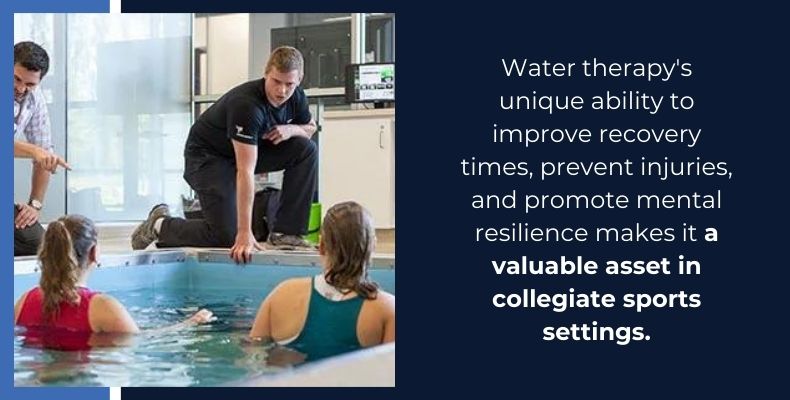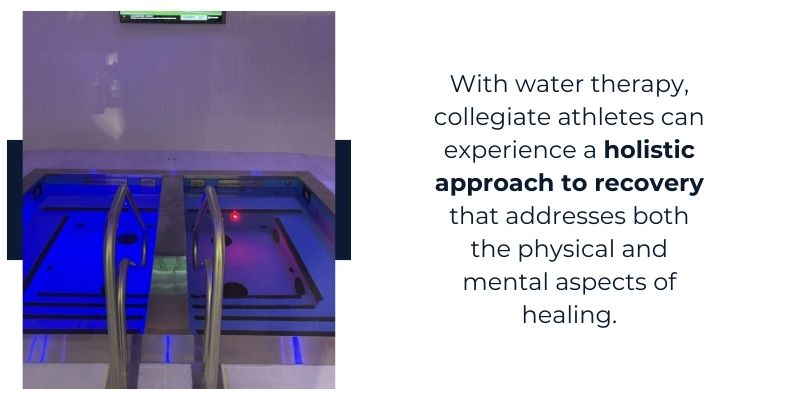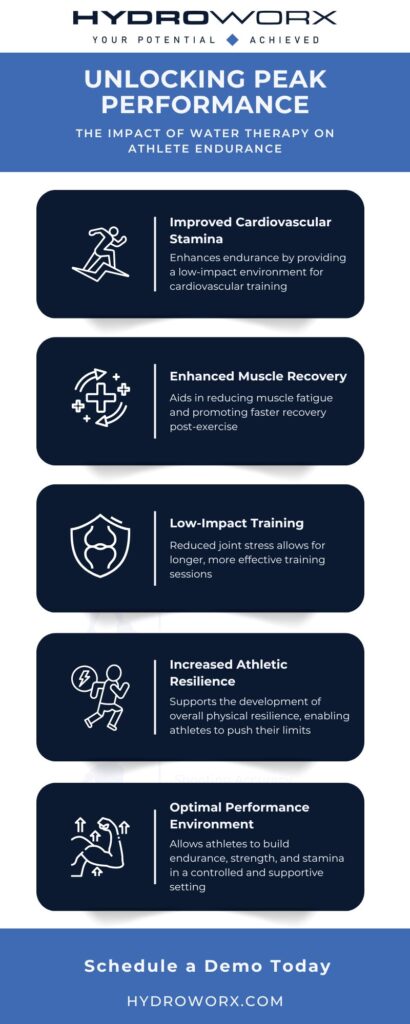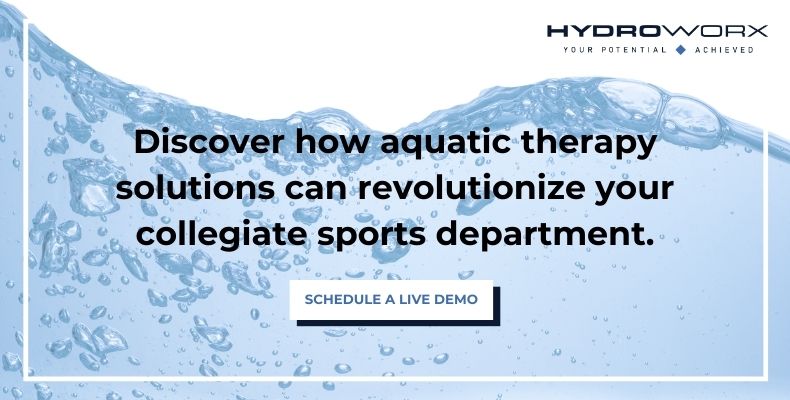The Role of Water Therapy in Collegiate Sports Departments
In collegiate sports, maintaining peak performance, injury prevention, and holistic athlete well-being are extremely important. Water therapy is a game-changing tool within collegiate sports departments, offering a range of benefits that contribute to athletes’ recovery, performance enhancement, and overall physical and mental wellness. By harnessing the therapeutic properties of water, collegiate sports departments can revolutionize their approach to athlete care and training, ushering in a new era of optimized athletic performance.
Water therapy’s unique ability to improve recovery times, prevent injuries, and promote mental resilience makes it a valuable asset in collegiate sports settings. In this blog article from HydroWorx, we’ll explore how water therapy is being used in collegiate sports departments to cater to the diverse needs of athletes and coaches. Let’s explore how water therapy is reshaping the landscape of collegiate sports, fostering a culture of holistic athlete care and performance excellence.

Enhancing Recovery and Injury Rehabilitation
Water therapy plays a pivotal role in enhancing recovery and injury rehabilitation for collegiate athletes. The hydrostatic pressure and buoyancy of water create a unique environment that accelerates the healing process and supports athletes in their journey back to peak performance. By reducing the impact on joints and muscles, water therapy enables athletes to engage in rehabilitation exercises with less strain, promoting faster recovery times and improved mobility.
HydroWorx’s innovative aquatic therapy solutions provide collegiate sports departments with the tools to optimize athletes’ recovery processes. The underwater treadmill integrated into therapy pools allows athletes to engage in controlled, low-impact movements that mimic land-based activities without the risk of exacerbating injuries. This tailored approach to injury rehabilitation not only speeds up the recovery process but also helps athletes regain strength and function more efficiently.
With water therapy, collegiate athletes can experience a holistic approach to recovery that addresses both the physical and mental aspects of healing. By incorporating water therapy into their training programs, collegiate sports departments can set the stage for enhanced performance and long-term athletic success.

Boosting Athletic Performance With Water Therapy Techniques
Water therapy techniques have a profound impact on enhancing performance, endurance, and overall athletic capabilities in collegiate sports. By incorporating water therapy into training programs, collegiate athletes can experience a range of benefits that contribute to improved physical fitness and enhanced sports performance. Let’s explore how water therapy techniques help boost athletic performance and endurance in collegiate sports departments:
- Water’s Resistance Training: Water provides natural resistance that challenges athletes’ muscles, leading to enhanced strength, power, and endurance. This resistance training in water helps athletes build muscle tone and improve cardiovascular stamina, contributing to overall performance.
- High-Intensity Workouts: Water therapy allows for high-intensity interval training sessions that elevate heart rate, increase metabolism, and enhance athletic conditioning. By engaging in intense workouts in the water, athletes can improve their endurance levels and push their physical limits.
- Recovery and Regeneration: Water therapy aids in faster recovery and muscle regeneration, enabling athletes to bounce back quickly from intense training sessions and competitions. The hydrostatic pressure of water helps reduce inflammation, relieve muscle soreness, and promote quicker recovery times, allowing athletes to maintain peak performance levels consistently.
- Balance and Stability Training: Water’s buoyancy challenges athletes’ balance and stability, requiring core engagement and muscle coordination. By incorporating balance and stability training in water, athletes can enhance proprioception, posture, and overall stability, leading to improved athletic performance on land.
By implementing water therapy techniques, collegiate sports departments can optimize athletes’ performance, boost endurance, and elevate their overall athletic capabilities.

Injury Prevention and Management Strategies With Water Therapy
Water therapy techniques play a crucial role in preventing injuries, managing pain, and promoting long-term athletic well-being in collegiate sports. The unique properties of water, including buoyancy, resistance, and hydrostatic pressure, offer a safe and effective environment for athletes to enhance their physical conditioning, reduce the risk of injuries, and address existing musculoskeletal issues. By incorporating water therapy into injury prevention and management strategies, collegiate sports departments can prioritize the health and well-being of their athletes.
- Buoyancy Support for Joint Protection: Water’s buoyant force reduces the stress on joints, ligaments, and tendons, providing a supportive environment for athletes to exercise without excess strain. This buoyancy support helps protect vulnerable areas from impact and minimizes the risk of overuse injuries during training sessions.
- Resistance Training for Strength and Stability: Water resistance challenges athletes’ muscles, promoting strength development, muscle activation, and overall stability. By engaging in resistance training in water, athletes can improve their muscle tone, enhance core strength, and reduce the likelihood of muscular imbalances that can lead to injuries.
- Hydrostatic Pressure for Recovery and Pain Management: The hydrostatic pressure of water aids in reducing inflammation, alleviating pain, and promoting faster recovery from workouts and injuries. Athletes can benefit from the therapeutic effects of hydrostatic pressure in water, which can help manage pain, reduce swelling, and enhance the healing process for long-term athletic well-being.
- Balance and Proprioception Training: Water’s dynamic environment challenges athletes’ balance, coordination, and proprioception, leading to improved body awareness, posture, and neuromuscular control. By incorporating balance and proprioception training in water therapy, athletes can enhance their stability, reduce the risk of falls, and prevent injuries related to poor balance and coordination.
By emphasizing injury prevention and management strategies with water therapy techniques, collegiate sports departments can create a proactive approach to athlete care, ensuring the longevity and success of their athletes’ sports careers.

Integrate Water Therapy Into Your Training Program
Discover how aquatic therapy solutions from HydroWorx can revolutionize your collegiate sports department. Contact us today to explore how water therapy can enhance recovery, injury rehabilitation, and overall athletic performance for your collegiate athletes. Together, we can transform your approach to athlete well-being and training.

